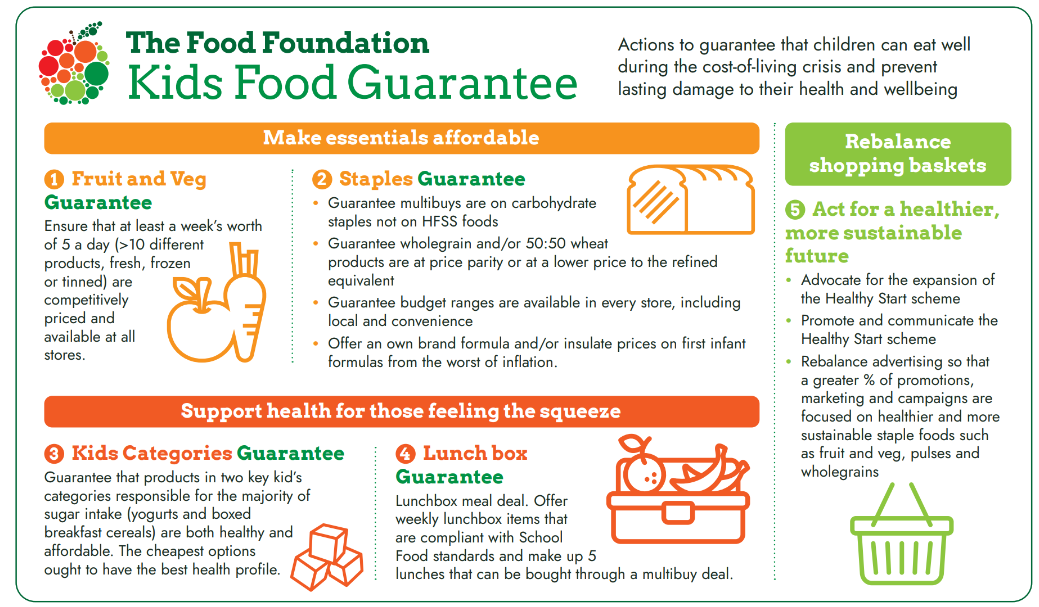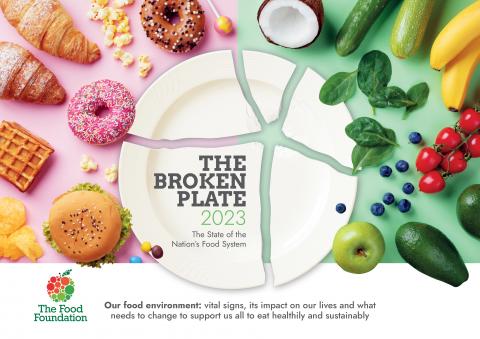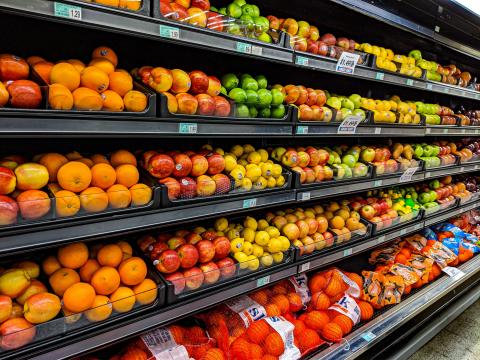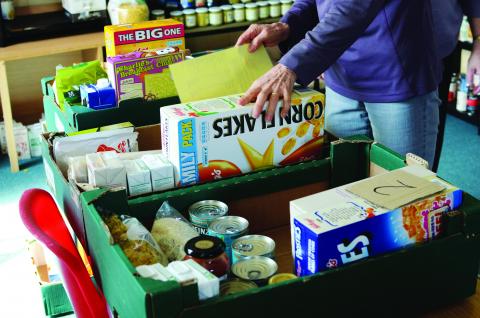About The Food Foundation
We are a young, dynamic, and impactful charity with a mission to change food policy and business practice to ensure everyone, across the UK, can afford and access a healthy diet supplied by a sustainable food system. We are independent of all political parties and business. We work with others who believe there is a problem with the system and want to change it. Visit our website for more information: www.foodfoundation.org.uk
Introduction
A strong food system should create food environments which support access to affordable, healthy, delicious food for all. However, the current food system is not serving us well. Food environments are unbalanced with less healthy foods often being cheaper, more heavily marketed and more accessible. There are opportunities for governments and retailers to take action to improve the food supply chain and the foods available to people to ensure that healthier food is accessible and affordable for all.
Our written evidence focuses on providing answers to part of question 6, and then questions 9-11. The headline messages of our written evidence are:
- Since April 2022, the price of a nutritionally adequate weekly shop has risen by approximately 25%.
- Food Foundation research shows that multibuy offers in UK supermarkets are overwhelmingly on high fat/salt/sugar (HFSS) foods, with very few on staples and fruit and vegetables.
- Healthy food is twice as expensive as less healthy food, which contributes to dietary and health inequalities.
- Benefits are currently insufficient to cover the cost of a healthy diet. Nearly half of those receiving Universal Credit (including those in work) are experiencing food insecurity.
- Changing food environments would be more effective than education in improving people’s diets. Unsustainable work patterns, and the ubiquity of takeaways often make the healthy choice the difficult choice.
Written response
Q 6. What is the relationship between food production costs, food prices and retail prices? How have recent movements in commodity prices and food-price inflation been reflected in retail prices? What are the consequences of current relationships in the supply chain for:
c. prices for consumers
The Food Foundation’s Basic Basket Tracker provides an indication of how the cost of a weekly shop that is nutritionally-adequate for an adult woman and man is being impacted by the cost of living crisis. Since tracking started in April 2022, the price of a food basket has increased in price by approximately 25%. This is higher than official food inflation figures which are not based on items that reflect a typical food shop and do not take dietary requirements into consideration.
The impact of high food prices is evident by concurrent increases in food insecurity levels. The Food Foundation’s Food Insecurity Tracker shows that food insecurity levels doubled over the course of 2022 and levels are not falling in 2023: our most recent findings show that almost 1 in 5 (17%) households experienced food insecurity in June 2023, affecting approximately 9 million adults and 4 million children living in those households.
e. healthy food for consumers
The Food Foundation’s Food Insecurity Tracker also shows that food insecure households are substantially more likely to be cutting back on healthy foods such as fruit, veg and fish compared to food secure households. This could further widen pre-existing inequalities in diet-related health.
Affordable and healthy food
Q 9. How successfully are supermarkets promoting affordable and healthy eating in the current high food inflation environment and what steps could they take to increase the take-up and affordability of healthy options? How are promotions, such as multi-buy offers, supporting healthy eating including for those on low incomes, and also affecting levels of food waste?
The Food Foundation’s latest Broken Plate report showed that a third (33%) of food and soft drink advertising spend goes towards confectionery, snacks, desserts and soft drinks compared to just 1% for fruit and vegetables.
The Food Foundation, in conjunction with the Questionmark Foundation, an international non-profit think tank, conducted analysis to look at what types of foods are included as part of multibuy promotions.
The data (collected between 18th and 24th April 2023) shows that almost a third (29%) of volume promotions or multibuys available in British supermarkets are on high fat, salt and sugar products (HFSS), with just 3% on staple carbohydrates, 3.8% on fruit and vegetables and 1% on milk. Just one promotion was found on eggs – a packaged snacking option rather than a carton of eggs intended for everyday use.
More details of this survey can be found here.
Q 9 Recommendations:
This analysis shows that action is needed to rebalance marketing and promotional spend to ensure that healthy foods like fruit and veg are better promoted to customers.
- The Government should reconsider their delay of the planned ban on HFSS promotions. Unless urgent action is taken to rebalance the food environment, the government’s goal of halving childhood obesity by 2030 will be missed.
- The Government must also press ahead with its existing commitments to restrict the prevalence of junk food advertising on TV and online, and act to reduce the prevalence of unhealthy food and drink advertising in outdoor areas
- In the meantime, other retailers ought to follow Sainsbury’s and Tesco responsible business leadership in committing to ban promotions on HFSS foods.
- The Food Foundation is also calling for retailers to support families through the cost of living crisis with a set of actions outlined in the Kids Food Guarantee. This includes a series of asks focused making essentials such as fruit and veg and staples affordable, supporting the healthiness of products, particular those consumed by children, and rebalancing shopping basked to support a healthier, more sustainable future. Full details are shown below:

Q 10. What challenges do low-income households face, in both urban and rural areas, in terms of accessing affordable and healthy food from a choice of retailers?
Dietary inequalities
Although dietary targets are, for the most part, missed across all parts of the population, significant dietary inequalities do exist, and people in the most deprived groups in the UK have poorer quality diets overall. Research published in the Food Foundation’s Broken Plate 2023 Report showed that:
- The least deprived fifth of adults on average meet the recommended intake of 5-a-day, but the most deprived fifth consume just 3.2 portions of fruit and vegetables per day.
- The most deprived fifth consume less than half the quantity of oily fish that the least deprived fifth do.
- 1 in 4 (24%) children aged 5 have dental decay. Dental decay is 2.5 times more likely to affect children in the most deprived fifth of the population compared to the least deprived.
- Across England and Scotland, children living in the most deprived fifth of the population are more than twice as likely to experience obesity by their first year of school compared to the least deprived fifth.
- Women in the most deprived tenth of the population can expect to live 19 fewer years of life in good health than the least deprived tenth, and similarly men experience an 18-year difference on average.
Affordability of a healthy diet
Accessing food that is both healthy and affordable is increasingly difficult for people on low-income. Data presented in The Food Foundation’s Broken Plate 2023 Report showed that:
- The most deprived fifth of UK households would need to spend an estimated 50% of their disposable income (after housing costs) on food in order to eat in line with the Eatwell Guide, the Government’s recommended healthy diet.
- The situation has deteriorated from the previous year where the most deprived fifth would need to spend 43% of their disposable income.
The cost of healthy food
According to data presented in The Food Foundation’s Broken Plate 2023 Report:
- On average more healthy foods (as defined by the Government’s Nutrient Profile Model) are over twice as expensive as less healthy foods per calorie (£10.00 per 1,000kcal compared to £4.45).
- In the past two years, more healthy foods have increased in price by £1.76 per 1,000kcal compared with £0.76 for less healthy foods.
- When broken down by Eatwell Guide category, fruit and vegetables remain the most expensive category by a significant margin, costing on average £11.79 per 1,000kcal compared with food and drink high in fat and/ or sugar costing just £5.82 per 1,000kcal.
While these price differences have been consistent for several years, the rising cost of living means ever-growing numbers of people need to squeeze their budgets, making them increasingly likely to be pushed towards less healthy options.
There are also concerns around affordability of infant formula for babies that require this form of feeding. All first infant formula products on the UK market must comply with regulations on nutrition composition which means they are all judged to be safe and suitable to support adequate growth and development. Despite this there are a large range of prices with Food Foundation research showing across nine of the biggest retailers, the price of a tin of powdered formula ranges from £9.39 to £15.95, a difference of £6.56. Furthermore, no first infant formulas are affordable with the Healthy Start allowance, which provides funds to spend on fruit, veg, milk and formula for low-income families with children aged under four.
Food Insecurity in Households in Receipt of Benefits
Benefit levels such as Universal Credit are not currently calculated based on the income that is needed to ensure people can afford a healthy diet alongside other essentials.
A new survey from The Food Foundation shows that nearly half (48%) of households on Universal Credit experienced food insecurity in June 2023. This is significantly higher than for households not in receipt of Universal Credit , which stands at 15%.
Data from the Department of Work and Pensions’ Family Resources Survey have shown similar patterns to Food Foundation data. The Family Resources Survey did show improved reduced food insecurity levels among Universal Credit claimants between 2019-20 and 2020-21, likely due to the £20 uplift which was in place at the time. This points to the critical role that increasing benefits could have in improving food insecurity levels.
Places to buy food on the high street
The food environment makes it difficult for people on all incomes to make healthy food choices. There is approximately 1 fast food outlet for every 1,200 people in the UK, a similar ratio to the USA. However, many other countries of comparable economic status have far fewer fast food outlets e.g. Spain which has 1 fast foot outlet for every 3,000 people. According to The Food Foundation’s Broken Plate 2023 Report:
- On average of 1 in 4 (25.6%) places to buy food in England are fast-food outlets, with no meaningful improvement in recent years (a range of 25.1- 26.2% over the five years of monitoring by the Food Foundation’s Broken Plate report).
- The average proportion of fast-food outlets is much greater in more deprived areas of the country – 21% in the least deprived local authorities compared with 31% in the most deprived.
The greater availability of fast food in deprived areas is likely to be a contributing factor to the socio-economic inequalities seen across obesity levels. Not only are takeaways damaging to health, but they can also create less pleasant neighbourhoods to be living in.
Last year South Tyneside Council refused plans for new takeaways because of their drive to reduce obesity. Gateshead Council have also shown strong leadership in this area, successfully reducing the proportion of fast-food outlets by 14% by utilising their planning policy.
This kind of protective regulation on the opening of fast-food outlets could simultaneously deliver benefits in tackling health inequalities while also increasing people’s satisfaction with the areas in which they live.
Access to affordable food
Research by Which? in April 2023 showed that major supermarkets are failing to make their budget-range brands available to people who have to shop in smaller stores, noting that ‘it’s often the poorest people who rely on convenience stores the most’.
Responding to this research before the Business and Trade Select Committee on 27 June 2023, David Potts, Morrisons’ CEO told the committee that he would be happy to put more budget ranges in Morrisons’ smaller stores. However, it remains to be seen whether this will in fact occur.
Q 10 Recommendations:
- The Government should actively track the cost of a healthy and sustainable diet to inform benefit levels and ensure that a healthy and sustainable diet is affordable for everybody, regardless of circumstance.
- Benefit and minimum wage levels should be set to ensure access to healthy and sustainable diet, as well as the cost of kitchen appliances, cookers, and energy costs.
- The Government should build on the success of the Soft Drinks Industry Levy by developing new fiscal policies that encourage businesses to reformulate other food and drink categories and rebalance the cost of more healthy and less healthy foods. The revenue raised should be invested into policies that make healthy foods more affordable and accessible for all.
- Local authorities should be better supported and encouraged to use their powers to transform their town centres and high streets to facilitate better diets and health.
- Supermarkets should be encouraged to have budget ranges available in all of their stores.
- VAT should be removed for restaurants and fast-food outlets that serve healthier and more sustainable meals.
- The Healthy Start scheme should be increased in value and have its eligibility extended. The extension of Healthy Start to children with no recourse to public funds should be made permanent.
- Introduce mandatory reporting and a consistent set of metrics for large food businesses to de-risk business investment in more healthy and sustainable food offerings.
Q 11. What measures could be taken by central and local government, and others, to enhance cooking skills to reduce reliance on processed food and improve access to self-grown food, in particular for lower income households? What challenges do such ambitions face given the pressures of modern living?
It is well established that educational initiatives which are focussed on changing individual behaviour are insufficient on their own to reduce obesity. Additional interventions that change the environment and societal norms are also necessary.
In the last 30 years the UK government has published 14 health strategies setting targets for obesity reduction, containing 689 policy recommendations. Most of these policies focused on relying on individuals to change their behaviour, rather than addressing the wider structural drivers of obesity and poor diet. The failure of these strategies has seen obesity and overweight rates continue to rise over this period, from 53% of adults in 1993 to 64% in 2019.
Policies which put the onus on the individual do not work well because they assume that people have the time, money, facilities and resources to take balanced decisions about what they eat, and have the motivation, means and ability to act. This is set out in more detail in The Food Foundation’s Purse to Plate report, which is based on ongoing research being undertaken by the Centre for Food Policy at City, University of London as part of the National Institute for Health and Care Research funded Obesity Policy Research Unit which is investigating the lived experience of families on low incomes to understand factors underpinning dietary decisions.
The report looks at issues as such as poor quality housing that provides insufficient space to store and prepare food as well as the issue of time pressures which can restrict people from doing the planning, shopping, food preparation and cleaning that is necessary to cook (and by logical extension grow) healthy food.
The findings show that those on low incomes often shop in a way that requires additional time and mental energy e.g. meal and budget planning, memorising prices, and shopping at multiple stores to find the best prices and deals. Higher income families however can afford strategies and technology that decrease the amount of time and labour required to prepare healthy meals e.g. kitchen appliances, home deliveries, car ownership, childcare.
As set out by the Resolution Foundation, workers with low-paid jobs often have the least protected time, with variable shift patterns and the least autonomy over their time. As has been additionally set out by the Work Foundation, low income women (ie. those who often shoulder the burden of domestic food work) are also more likely to have insecure employment, which results in even less autonomy.
This culminates in the time and energy needed for preparing healthy meals being simply unavailable to many. This naturally leads people towards pre-prepared ingredients or entire meals which are typically ultra processed and high in fat/salt/sugar.
Q 11 Recommendations:
- Everybody in our society should be guaranteed sufficient income to be to access healthy and sustainable food.
- Action should be taken to ensure everybody has access to an acceptable standard of kitchen space in order to cook sufficient meals.
- Action should be taken to increase the availability of healthy food outside of home settings, including to:
- Ensure every child has access to nutritious school food, putting children on an equal footing and eliminating stigma from our school canteens. As an immediate first step, the household earnings threshold for free school meal should be raised to cover to all children from families in receipt of universal credit, with the eventual aim of universal free school meals.
- Increase the volume of fruit and vegetables served at snack times and mealtimes in schools and expand the School Fruit and Vegetable Scheme so that all primary school children can benefit.
- Strengthen government procurement rules for schools, hospitals, prisons, and other public spaces where food is served so health and environmental standards become mandatory for all settings including 2 portions of vegetables being included as standard in all main meals.





